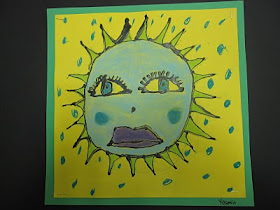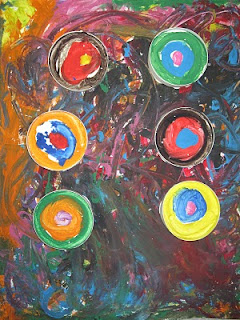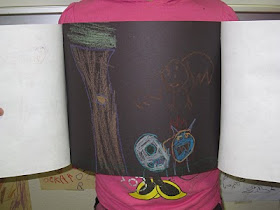
Thursday, November 18, 2010
Aztec Suns
 Second Grade students looked at different examples of suns commonly found in Mexican artwork. We discussed the connection between Aztec suns and modern Mexican suns. Students discovered that suns featured in Mexican artwork usually have faces that include cheeks. They drew their own sun using these characteristics. Then they glued over their lines with black glue. Finally, they used chalk pastel to color their suns.
Second Grade students looked at different examples of suns commonly found in Mexican artwork. We discussed the connection between Aztec suns and modern Mexican suns. Students discovered that suns featured in Mexican artwork usually have faces that include cheeks. They drew their own sun using these characteristics. Then they glued over their lines with black glue. Finally, they used chalk pastel to color their suns.Fingerprints
 Fourth Grade students used a jeweler's loupe to look closely at their fingerprints. They drew their fingerprints using as many details as possible.
Fourth Grade students used a jeweler's loupe to look closely at their fingerprints. They drew their fingerprints using as many details as possible.Students discussed the difference between famous and infamous. They talked about people that have made an imprint on their lives in a positive way. They discussed the fact that we made imprints on each other's lives everyday - both positive and negative. Finally, students wrote about a person that has impacted their life in a positive way, or a way they had positively impacted someone else.
Kandinsky!

First Grade students looked at artwork by Wassily Kandinsky and discussed how the artwork made them feel or what the artwork made them think about. They also looked at his famous artwork "concentric circles" which is a color study to see which colors look best next to each other. Students did their own color study on six take-out soup lids. They experimented with the way colors look next to each other. The next week students revisited Kandinsky's artwork and discovered that Kandinsky often painted while listening to music. Then they listened to different kinds of music to paint the background.
Monday, November 8, 2010
Huichol Yarn Paintings
 Fourth Graders have been working tirelessly for 6 weeks on these amazing yarn paintings. Students learned that yarn paintings are traditionally created by the Huichol people who live in mountainous regions of Mexico. Students learned that yarn paintings are tradionally created to offer to their gods for good luck with hunting and also for other ceremonial purposes. More recently these yarn paintings have been created to sell to tourists. Most yarn paintings feature bright colors and many feature animals. In Mexico, these paintings are created by pressing yarn into beeswax that has been spread on a board. We used glue and yarn on tagboard. Some students were able to cover their entire painting with yarn, while some focused on completing their animal.
Fourth Graders have been working tirelessly for 6 weeks on these amazing yarn paintings. Students learned that yarn paintings are traditionally created by the Huichol people who live in mountainous regions of Mexico. Students learned that yarn paintings are tradionally created to offer to their gods for good luck with hunting and also for other ceremonial purposes. More recently these yarn paintings have been created to sell to tourists. Most yarn paintings feature bright colors and many feature animals. In Mexico, these paintings are created by pressing yarn into beeswax that has been spread on a board. We used glue and yarn on tagboard. Some students were able to cover their entire painting with yarn, while some focused on completing their animal.Monday, November 1, 2010
Fall leaf prints


Second Grade students experimented with printing leaves. They learned printmaking vocabulary and discussed how printing and painting were different. Students also considered the compostion of their leaves on the page and tried to create a visually interesting arrangement
of leaves. Then students used Q-tips dipped in warm colored paint to paint the negative space in their compostion.
of leaves. Then students used Q-tips dipped in warm colored paint to paint the negative space in their compostion.
Dia de los Muertos

Fifth grade students discussed Dia de los Muertos (the Day of the Dead) and compared it to hoildays celebrated in the United States. Students shared personal experiences with this holiday. Students learned that Dia de los Muertos is similar to Memorial Day in the United States because it celebrates the good memories we have of loved ones who have passed away. Students looked at artwork traditionally created for Dia de los Muertos and found that skeletons are often used in decoration. However, unlike Halloween, these skeletons aren't meant to be scary. Students created artwork similar to decorations made for Dia de los Muertos. This was a mixed-media project that used construction paper crayons, scraps of fabric, air dry clay and markers.





















